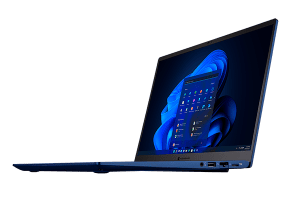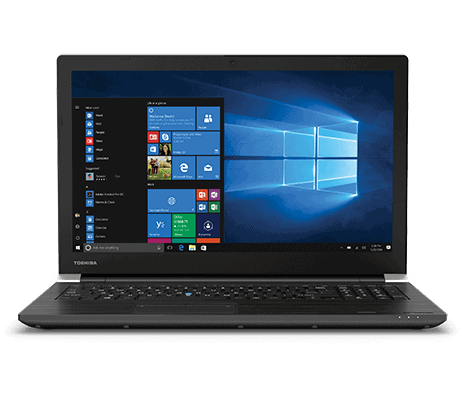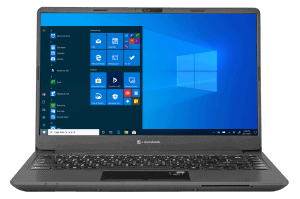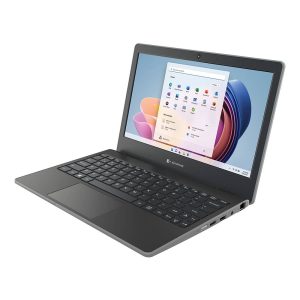Table of Contents
There are many great notebooks out on the market today. At Inacom, we provide solutions from Dell, HP, and Dynabook in our portfolio of Computer Support Services. This blog post is going to look at the options provided by Dynabook. If you’re not familiar with Dynabook’s story, a company known as Foxconn purchased Toshiba’s PC business back in 2018. The intention was for Foxconn to expand beyond their “behind the scenes” role as an OEM manufacturer and begin designing, building, and selling a consumer facing brand. You’ve probably come across (or used) Toshiba Satellite and Tecra notebooks in your past. If so, you’ve already been exposed to theri story.
General Features across the Dynabook Range of Notebooks
Before we discuss the differences between the different Dynabook series, let’s talk about some of the features that make them worthy of your consideration as a business class notebook PC when you might already be considering a notebook from Dell, HP, or Lenovo.
Proprietary BIOS
Dynabook writes its own secure BIOS (the base firmware executed when a PC is turned on and initializes the hardware and loads the OS). You’ll typically see a “BIOS screen” when your notebook boots up. Dynabook optimizes their BIOS to enhance tamper resistance, secures pre-boot communication, and optimize performance. You’ll be hard pressed to find a notebook manufacturer that has more experience working with the low level functions of PC components than Foxconn.
You’ll find other brands often rely on third parties to create the BIOS for their notebooks. Some of the major developers you’ll see at boot include American Megatrends, Phoenix Technologies, and Insyde Software. Competing brands will either contract with these BIOS developers to customize an existing BIOS for their systems, or they’ll do the job with their own internal team.
We don’t mean to insinuate that any of these BIOS manufacturers aren’t good at what they do. But you have to admit that when a manufacturer controls the hardware and the BIOS internally that’s an advantage.
My general rule of thumb for BIOS by Laptop Brand
Dynabook – In House
HP – Third Party (with internal customizations)
Dell – In House
Lenovo – In House
Rigorous Durability Testing
We’ve all had dud notebooks at some point in our past. Those types of laptops that fell apart before our very eyes and just didn’t last as long as you would expect. Or sometimes those accidents that can’t be avoided took out a system before it was due for scheduled replacement. Dynabooks are well tested for reliability against the MIL-STD810G standard. Sometimes this is referred to as “milspec.”
If you aren’t familiar with MIL-STD810G, the Department of Defense put together an extremely thorough testing process for their operating equipment. They test practically every environmental condition you could imagine to ensure that their equipment will remain in service and function during it’s expected lifecycle. MIL-STD810G is a well respected testing methodology throughout most industries. To be clear, MIL-STD810G doesn’t guarantee an indestructible notebook. But it does mean the product design is well thought out and should fair well against anything you throw at it in the course of typical business use.
Meant to deal with drops, crushing blows, temperature extremes and general abuse, milspec notebooks usually have metal covers, a stronger magnesium alloy chassis inside, sealed, weatherproof keyboards and seams, and overall higher quality components inside. Cheaper, non-durable notebooks are going to miss these marks.
All the other major brands do have models that are tested per MIL-STD810G. But they also offer models that would not pass such rigorous testing. Those are usually the budget choices where costs must be cut wherever possible to compete based on the lowest price.
HP Notebooks Tested to MIL-STD-810G
EliteBook, ZBook (some), ProBook x360 Education Edition (some), HP Chromebook. At this time of this writing, HP documented MIL-STD810G compliant notebooks here.
Dell Notebooks Tested to MIL-STD-810G
Dell Latitude Rugged are compliant across the line. We could not find documentation on the other lines, but the past has shown us that they tend to have less products that pass MIL-STD-810G than HP.
Lenovo Notebooks Tested to MIL-STD-810G
Lenovo tests their ThinkPads to MIL-STD-810G standards. They generally make fantastic notebooks of a very high build quality.
Value-Add Customization
All major notebook brands offer value-add customization in some form as an option. If you agree to buy enough at the right price-point, they’ll make systems just for you. In practical terms, most customers take standard product right out of the box. But we’ve had Sharp pre-configure bios settings, load custom images and engrave asset IDs on their notebooks. It’s a relatively painless process that does not add to lead time. The big catch is you need to order at least 25 systems. Many small businesses don’t have that many notebooks, but it’s a viable benefit for local government, healthcare, and many medium to enterprise level businesses. Figure for each custom loaded Dynabook notebook, you’ve cut your IT staff’s deployment time by up to an hour. Take care of those IT Support pros working for you!
The Different Dynabook Laptop Lines
As you can see, Dynabook compares very favorably to business class notebooks offered by HP, Dell, and Lenovo. You really can’t objectively say that any one manufacturer is substantially better than the other. So let’s take a look at the different lines offered by Sharp. Hopefully with these general descriptions you’ll have a sense of which models you want to consider for your next notebook purchase.
Portégé Series

Portégé is Dynabook’s portable line. Do you get the play on words? Current Portégé models have a 13.3″ screen, they’re very thin and light. Battery life is very good. Some Portégé models even come with the ultra-durable Gorilla Glass in the screen. Speaking of screens, they tend to have very large viewing angles, great for people who need to use the notebook in tight, industrial spaces. The Dynabook Portégé series has the absolute best build quality of the notebook line. They’re perfect for road warriors and personnel out in the field.
If your notebook is going to sit on a desk or in a bag most of the time, you might not want to invest in the mobility of Portégé. But if you have the need, we think the The ultra-slim Dynabook Portégé X40L-K is one of the best notebooks out there, period. It’s a slim model that weighs in at just 2.2 lbs and it has a great battery life.
Where does Portégé Fit?
Choose Portégé when portability and build quality matter. Outside sales, field technicians, and the C-types who want the coolest and sleekest are all good fits for Dynabook Portégé.
Tecra Series

Tecra is Dynabook’s line of powerful notebook PCs. You’re going to get a larger screen, faster processors, more RAM and storage. You can easily throw some Docker, k8s, or k3s containers on here or a VM or two for a development or demo environment. Expect lower battery life as all that computing power does require more energy. Tecra does offer a 15″ screen and a 10-key number pad, which are features that are becoming harder to find these days. Tecra is the line you want for power users and it’s a great choice for desk-bound notebooks, as well. A couple extra pounds or a shorter battery life don’t mean much when the system is mostly stationary.
Why should you choose Dynabook Tecra Notebooks?
Choose Tecra when you need a powerful notebook above portability. You’ll want to provide it to your techie types like engineers or people who love driving fast cars. Most everybody appreciates the larger 15″ screen.
Satellite Pro Series

Satellite Pro represents Dynabook’s more affordable line of laptops. When budget is a bigger concern, look here. These are still well made notebooks, but they sacrifice features such as a smaller footprint, lighter weight, longer battery life, or faster processors. Satellite Pro is typically slotted for general use notebooks, knowledge workers, and conference rooms. There is a 15″ screen option with a 10-key, making the Accountants happy based on functionality and purchase price. Sometimes Satellite Pro is a good choice for students or they are issued to teachers, as they offer a more computing power than is offered in the E Series notebooks for Education.
What is the best use case for Satellite Pro?
Choose Dynabook Satellite Pro when you need a value-priced, business class notebook for typical use scenarios. The 15″ screen is great ergonomically for the visually challenged and the 10-key is indispensable for the accountants in your life.
Dynabook E-Series Notebooks for Education

As computing in our school systems continues to become more important, Dynabook is making an aggressive play into the education market. Products like the Dynabook E-10 are optimized for in-person and remote learning. We love the rubber bumpers, reinforced hinges, and spill-proof keyboard as features that address common failures when young students are carrying around notebooks. An optional 3 year warranty will help you match the lifecycle of your Dynabook E-10 with your 36 month FMV lease, minimizing the chance you’re stuck buying broken computers back from your leasing partner.
Compute-wise, E-series offers “just enough” to get the job done. You might not consider a 720p webcam, an 11″ screen, or 4GB of RAM powerful enough for business use. There are upgrades available to make them a bit more powerful. This class differentiation might be useful for Elementary students vs Middle Schoolers or High Schoolers. But for this light use case, the hardware is at least adequate for the job. Most educational systems are looking at school notebooks more as consumables than long term assets based on the amount of wear and tear they experience, and the Dynabook E-10 will stay relevant for the next 36 months. And it’s hard to beat the cost of these Windows-based Education notebooks. Typical systems price out at $300 – $400 per machine, with quantity discounts available for larger buys.
Easily Purchase the Dynabook E-10 via SourceWell
Sharp is a big player in the Government and Educational markets. They primarily get their Dynabooks and copiers sold through SourceWell. If you’re a government agency, education system, or non-profit you’re probably eligible for SourceWell membership. Once you’re an eligible SourceWell member, you gain access to their pre-negotiated pricing schedule. This means you can get an extremely competitive, discounted price even if you only want to order a handful for your own durability testing to see if the Dynabook E-10 is a good fit for your use case.
Are you Interested in Buying Dynabooks for your Organization?
Inacom has been providing business technology since 1982. We have a long track record selling all types of business and education class notebooks from all major brands. We’ve seen first hand that Dynabook compares favorably against all of them. If you need a SourceWell vendor selling windows-based student laptops we’d love to chat with you.

